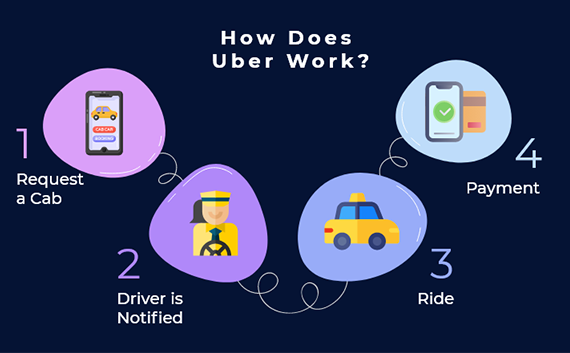-
UberX is the basic Uber ride.
-
Uber Pool: Shared rides
-
Uber Comfort: New vehicles with more legroom.
-
Uber Green: electric vehicles
-
Uber Black: Luxury cars
-
Electric bikes on demand.
-
Scooters are electric scooters.
-
UberXL: Vehicles that can carry up to six people.
-
Uber Transit: Information on public transport in real-time.
-
Uber WAV - Wheelchair accessible vehicles
-
Uber Lux: Luxury cars with the best drivers.
-
Uber Black SUV: Luxury SUVs driven by top-rated drivers
-
Uber Taxi: Local taxicabs have partnered with Uber.
-
Uber Flash is a specialized taxi service designed for Hong Kong.
-
Uber Auto: Auto rickshaws on demand.
-
Uber Air: Flying cars
Dev Technosys offers expert dedicated developers under a flexible Time and Material model to turn your vision into powerful, scalable digital solutions
Step into the passenger seat as we embark on a thrilling journey to unravel the captivating world of Uber and its groundbreaking business model. Buckle up because we're about to hit the accelerator and delve into 130 words of sheer innovation and disruption.
Imagine a world where transportation is at your fingertips, effortlessly summoned with a simple tap on your smartphone. Uber, the trailblazing ride-hailing giant, has revolutionized how we travel, reshaping the urban landscape and rewriting mobility rules. Through a seamless blend of technology and transportation, Uber connects many riders with a vast network of drivers, creating an on-demand experience like no other.
But Uber business model brilliance extends beyond convenience. With its asset-light approach, Uber has disrupted the traditional taxi industry, creating new opportunities for drivers and redefining the meaning of work. From ride sharing to food delivery and freight, Uber's innovative ecosystem continues to expand, transforming how we move, eat, and ship goods.
Join us as we dissect the intricacies of Uber business model and uncover the secrets behind its global success. Get ready to embark on a ride you won't soon forget!
Uber’s Facts, Figures And Fundings
| Launch Year | March 2009 |
|---|---|
| Founders | Garrett Camp Travis Kalanick |
| Parent Company | Uber Technologies, Inc. |
| Headquarter | San Francisco, California, U.S. (Uber origin country) |
| Industry | Mobility as a Service |
| Funding Amount | $25.2B |
| Number of Users | Over 500 million guests and 4 million hosts in over 220 countries and regions |
| Funding Stages | 33 |
| IPO Launch | May 9, 2019 |
| IPO Amount | $82.4B |
| Acquisitions | 13 |
| Customer Base | 93M (2021) |
What is Uber?
Uber is a mobile app that allows you to book a taxi from A to B. It calculates the price in advance, estimates the arrival time, and offers the option to share the cost with other riders. In 2008, the company's founders couldn't find a taxi on a cold evening in winter. The Uber success story began with a simple thought - "What would happen if you could request a cab from your smartphone?"
Uber Air is affordable for those who want to ride a bike or scooter.
Uber Market Statistics
-
Uber, a ride-hailing platform and food delivery service founded in 2009, is an international company.
-
Uber business model made amazing record, over 10 billion journeys since its launch.
-
Uber has over 93 million monthly active platform users as of September 2021.
-
Uber's gross bookings for the first quarter of 2021 were $19.5 billion.
-
Uber turnover in 2020 will be $11.14 billion.

-
Uber's 2020 net loss was $6.77 billion.
-
Uber's estimated market capitalization in September 2021 is approximately $70 billion.
-
In 2021, Uber is expected to have a 70% market share in the United States.
-
Uber Eats is the food delivery division of Uber. It has experienced rapid growth and has an estimated global market share of 25% by 2021.
-
Uber has approximately 4 million drivers active worldwide as of September 2021.
-
Uber Technologies is expected to generate a net income of around 31,88 billion by 2022. Around 130 million people use the mobile transportation network every month.
How Does Uber Work?

Before going further in this blog to learn Uber business model it is important to know how does uber work. Garrett Camp and a few of his friends developed the Uber application in its initial stages. The application was later developed to achieve the goal. The development of applications was a difficult task in the past, but many companies now build apps in a matter of weeks. Uber is easy to use:
Step 1: Request a Cab
Open the app to request a ride. Here, customers can select a mini, medium, or luxury car.
Step 2: Driver is Notified
Once the user submits a request, all riders in the area are notified. When a driver accepts the ride, his information is returned to the user.
Step 3: Ride
App users can also view the ETA. The meter begins as soon as you start riding and stops when you reach your destination.
Step 4: Payment
The rider must pay the total amount due to them at the end of the trip. The app calculates prices based on the distance and the base fare.
Uber Business Model Canvas

Uber is more than a taxi service. Uber's model is flexible and can be adapted by any type of business, regardless of size. We will simplify the Uber business model by breaking it into key elements.
Key Stakeholders
This uber business model allows you to keep your key stakeholders involved in the process. The key stakeholders of this business model include:
Your app will be used by riders to book rides.
Your technology will help drivers reach more passengers and earn more money.
You can find technical service providers who will supply you with digital tools.
The service providers are your best ally when it comes to managing ride services.
You will be at the heart of your business with central management.
Investors provide crucial financial and decision support.
Key Activities
A key activity is another essential core of Uber business model that create a digital booking platform that allows your customers to book taxi rides through your web and app portals. Other important activities include:
The technology stack is used to create a structure.
Drivers and ride request fulfillment through a partnership
Digital tools allow you to manage and fulfill ride requests.
Payment gateways provide a convenient and easy way to make payments.
You will be at the heart of your business with central management.
Engagement of consumers through social media and marketing.
Key Resources
Resources are the reservoirs of expertise and support that keep your business afloat. The Uber business model is built on the following:
Platforms such as on demand app development and web portals that work across all operating systems.
Drivers equipped with the latest smartphones.
Partners with well-organized web portals.
Value Propositions
Riders
Riders/users are shareholders in a business model and benefit from this in several ways.
The nearest drivers and shortest routes are assigned to the riders.
Estimate the fare before booking and cancel for free.
Apps offer convenient and preferred services.
Cheaper rides and competitive pricing are great ways to save money.
A wide range of payment methods is available, such as electronic wallets, debit/credit cards, etc.
Live tracking for a ride that is in progress.
Drivers
The more drivers you have, the more success you'll experience. The benefits that drivers can enjoy include:
More rides can increase the earnings of drivers.
Easy registration and validation.
The ability to choose their work hours.
The driver can select a payment option that is convenient for them.
Customer Relationships
This uber business model will help you to achieve the long-term success of your business by:
Social media and website marketing
Marketing can increase the impact of your brand.
Customer support is always available.
Review and feedback system with full functionality.
Customer Segments
This uber business model helps drivers and customers by focusing on specific users and using innovative technologies.
Customers
Customers can also contact us by clicking here.
Rides without private vehicles
The riders are not able to drive themselves.
Riders want to find cheaper options for rides.
Riders seeking convenient and luxurious services.
Drivers
We have already mentioned that drivers are the key to the success of any online taxi booking or ride-hailing business. You need to know the type of driver you want to work with.
Drivers who are looking to earn more money through their vehicle.
Drivers who want to work flexible hours.
The people are seeking a way to live with security and status.
Channels
With a technical structure based on Uber business model, you can create digital tools to support your taxi booking business.
Apps for drivers and riders on Android and iOS.
Dashboard central admin for the management of all departments.
Driver and rider web portals.
Partners can now access portals to better manage their rides.
Uber's Revenue Model
Now that you know Uber business model it is crucial to learn“How Uber Makes Money?"Here's a breakdown of Uber's revenue models:
Ridesharing Revenue
Uber's core service, ridesharing, generates most of its revenue. Uber takes a cut of the total fare for each ride, usually 25-30%.
Surge Pricing
Uber uses surge pricing (dynamic pricing and surge multiplier) during periods of high demand. The fare increases to encourage drivers to be more available at peak times. Uber makes additional revenue by charging higher fares for surge pricing.
Uber Eats
Uber Eats is a food delivery service that has added to its offerings. Uber charges restaurants a fee for partnering with them and utilizing their delivery network. Uber charges customers a fee for every order they place through the Uber Eats application.
Other Delivery Services
Uber now delivers other items, such as packages, groceries, medications, and medication. Uber Eats charges businesses a fee for using its delivery network.
Uber Freight
A digital marketplace called Uber Freight links shippers and carriers. For each transaction conducted on its platform, Uber assesses a transaction fee to both shippers and carriers.
Uber Rentals
A partnership between Uber and rental car companies allows it to offer car rental services. Uber customers can rent a vehicle for a specified period through the app. Uber receives a fee or commission for each rental booked through its platform.
Advertising
Uber generates revenue from advertising. Uber offers advertising space in its app to allow businesses to market their products and services to Uber users. Uber charges advertisers to display their ads within the app.
Uber Rewards
Uber Rewards is a loyalty program that allows users to earn points on every dollar they spend for eligible Uber Eats and Uber Rides. Uber has partnered with many brands, and users can redeem their points for discounts with the partner brands. Uber earns revenue from these partnerships and commissions.
Other Revenue Streams
Uber has also explored other revenue streams, such as bike and scooter rental, partnerships with public transport agencies, and corporate travel programs. These initiatives could involve revenue-sharing agreements with partners or fees charged.
Uber's Competitors
Lyft
It is a major competitor. The company was founded in 2012. It provides services in the U.S., in over 220 cities, and offers 18.5 billion rides a month. The company went public with a valuation of $24 billion.
Curb
The business is owned by VeriFoneSystems and is run using its credit card terminals. The majority of New York's green and yellow cabs are run by Curb, which was founded in 2015. It wants to increase its operations all around the country.
DidiChuxing
Despite only having been founded in 2009, it is now China's biggest corporation. Its app offers services like Didi Test Drive and DiDi Chauffeur. In 2015, the company made 1.4 billion journeys, and in 2016, its market worth was $28 billion.
OlaCabs
In 2010, it began as an online taxi aggregator in Mumbai. The network now reaches Australia, New Zealand, and the U.K. Its valuation in 2015 exceeded $5 billion. Ola currently has a market share of more than 60% in India.
Grab
The company was founded in Singapore in 2011 and offers services to the Philippines, Indonesia, Vietnam, Thailand, Myanmar, Malaysia, and Myanmar. Grab launched a messaging feature on its app at the end of 2016 that allows language translations. It helped break down this barrier in Asia.
Cabify
The safest in the business is Cabify, which was introduced in Spain in 2011. It has geo-tracking, sophisticated vehicles, and skilled drivers. The corporation has operations in Portugal, Chile, Brazil, Peru, Spain, Mexico, and Chile.
Yandex Taxi
The Russian company provides food delivery and ridesharing services throughout the Middle East, Russia, and Eastern Europe. It is also a leader in developing self-driving cars. By the end of 2018, more than 700 000 drivers had completed over 1 billion rides.
Uber SWOT Analysis
Strengths
Strong brand recognition exists for Uber. One of the most well-known brands in the sector. Its name is a byword for convenient and reasonably priced transport services.
Global Presence
Uber is available in more than 600 cities worldwide, making it the largest ridesharing platform. Uber's extensive network enables it to serve a wide customer base and utilize economies of scale.
Technological Innovation
Uber is at the forefront regarding technological advances within the transportation industry. Uber's mobile app has revolutionized how people book and pay for rides. It provides a convenient and seamless user experience.
Diverse Services Offered
Food delivery and freight transportation have been added to Uber's list of services, which now also includes its primary ride-hailing service (Uber Eats). Diversification lowers risks and increases earnings.
Weaknesses
Challenges to Regulatory Reform
Uber has faced many regulatory challenges due to the resistance of traditional taxi services and local governments in many markets. Taxi app development challenges have led to bans, fines, and legal battles, which have negatively affected its operations and reputation.
Costs are High
Uber relies on independent contractors to drive its vehicles, which can result in increased costs for insurance, driver incentives, and legal fees. The company has also invested heavily in marketing, research and development, and expansion. It has resulted in significant losses.
Safety Concerns
Uber has been criticized and faced legal issues regarding passenger safety. It has been criticized for its inability to protect riders from assaults and other misconduct.
Opportunities
Resources are the reservoirs of expertise and support that keep your business afloat. The Uber business model is built on the following:
Emerging Markets
Uber can expand its services into emerging markets with growing demand for affordable and convenient transportation. Uber's brand recognition and technology expertise can help it capture market share in these markets with significant growth potential.
Partnerships and Collaborations
Uber can form strategic partnerships with companies to enhance its competitive edge and expand its service offering. Collaborations with retailers, restaurants, and public transport systems can generate new revenue and attract more customers.
Autonomous Vehicles
Uber can reduce its dependence on human drivers by adopting autonomous vehicles and lowering operational costs. Uber can become a leader in the future transportation industry by investing in self-driving technology or partnering up with manufacturers.
Threats
The Intense Competition
Ride-hailing is a highly competitive industry, with established players and newcomers vying to gain market share. Uber's dominance in the market is threatened by competitors such as Didi Chuxing and Grab, while aggressive marketing and price wars can also erode profits.
Changes in Regulations
Uber's profitability and operations can be significantly affected by changes to government regulations. Increased regulations, such as more stringent background checks for drivers or a stricter classification of the drivers as employees, can increase costs and reduce flexibility.
Consumer Preferences are Changing
The transportation preferences and behavior of consumers can rapidly change. Uber could see a drop in demand if customers choose other modes of transportation or move towards car ownership.
How Can Dev Technosys Help In Developing An App Like Uber?
Dev Technosys can help in developing an app like Uber by providing comprehensive app development services. Our expertise lies in creating robust and scalable mobile applications with advanced features like real-time tracking, secure payment integration, user profiles, and driver matching algorithms. We can assist in designing a user-friendly interface, developing a backend infrastructure, and ensuring seamless communication between users and drivers.
Dev Technosys follows a systematic development approach, including requirements analysis, prototyping, testing, and deployment, to deliver a high-quality Uber-like app. With our dedicated developers technical proficiency and industry experience, we can customize the app to meet specific business requirements and deliver a reliable and efficient solution.

















